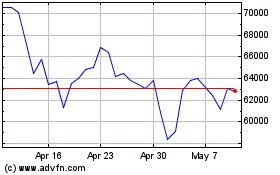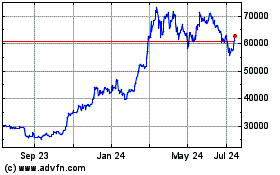Ethereum Co-Founder Predicts Supply Crunch From ETFs, This Is The Price Target
May 22 2024 - 2:50AM
NEWSBTC
Joseph Lubin, co-founder of Ethereum and CEO of blockchain
technology firm Consensys, has expressed that the potential
approval of spot Ethereum ETFs by the US Securities and Exchange
Commission (SEC) could lead to significant supply constraints for
Ether. This development is anticipated to be a “watershed” moment
for Ethereum. In an exclusive interview with DL News, Lubin
predicted that the approval of spot Ethereum ETFs will unlock
substantial institutional demand. Given that many institutions have
begun their crypto investments with spot Bitcoin ETFs, Ethereum is
naturally the next substantial asset for diversification. “There’s
going to be a pretty large amount of natural, pent-up pressure to
purchase Ether” through these ETFs, Lubin commented. However, he
also noted that the situation for Ethereum differs significantly
from that of Bitcoin because of the underlying supply dynamics. A
major factor distinguishing Ethereum from Bitcoin in the context of
ETF creation is the availability of the assets. On-chain data
indicates that more than 27% of all Ether is staked across various
protocols on the Ethereum network. These funds are locked in
contracts and are contributing to the network’s security and
operations, thus they are not readily available for market trading.
“Much of the Ether is put to work in the core protocol, DeFi
systems, or in DAOs,” Lubin explained. This structural difference
means that there is less Ether available for ETF providers to
purchase and allocate to new ETF shares. Related Reading: Ethereum
Soars 20%: ETH Hype Escalates on ETF Rumors In August 2021, the
Ethereum network’s EIP 1559 introduced a burning mechanism where a
portion of the Ether used for transaction fees is permanently
removed from circulation. This deflationary mechanism is designed
to balance Ether supply growth and potentially increase its
scarcity over time. As network activity increases—potentially
spurred further by new institutional interest in Ethereum through
ETFs—this burn mechanism will gradually reduce the available
supply, adding another layer to the potential supply crunch. “This
could be a pretty profound watershed moment”, Lubin said. Ethereum
Price Targets And Doubts The market impact of an approved Ethereum
spot ETF could be significant. Crypto analyst Miles Deutscher
projected a possible scenario where Ethereum could see a price
surge similar to that experienced by Bitcoin following its own ETF
approval. According to Deutscher’s analysis, “BTC rallied 75% in 63
days after the spot ETF was approved. If ETH follows the same trend
(if approved), this would take it to $6,446 by July 23.” $BTC
rallied 75% in 63 days after the spot ETF was approved. If $ETH
follows the same trend (if approved), this would take it to $6,446
by July 23. pic.twitter.com/FfWg9VGUMx — Miles Deutscher
(@milesdeutscher) May 21, 2024 However, opinions among analysts
vary. Vetle Lunde from K33 Research pointed out the challenges in
replicating Bitcoin’s success, noting that the futures-based
Ethereum ETFs have only captured a small fraction of the assets
compared to their Bitcoin counterparts prior to spot ETF approval.
“Fut-based ETH ETFs have seen cumulative net inflows of $126m since
launch ~ roughly equivalent to the inflow to BITX over the past 3
days. Fut-based ETH ETFs aggregated AUM is only 7.4% of the
AUM fut-based BTC ETFs had before the spot approval,” he remarked.
Related Reading: Crypto Market Liquidations Top $330 Million In 24
Hours With Ethereum In The Lead Meanwhile, crypto analyst Vijay
Boyapati raised concerns about the structural differences in ETFs,
specifically the inability of ETF structures to incorporate
staking. “It should be noted that the ETH ETFs, if approved, will
be a much worse proxy for the underlying asset than BTC ETFs
because the SEC is still extremely unlikely to allow the ETF
applicants to stake,” he said. This could result in the ETFs not
fully reflecting the underlying value growth of Ethereum price, as
also highlighted by Alex Thorn, Head of Research at crypto-focused
financial services firm Galaxy commented: “Lack of staking in ETH
ETPs would be material for returns. If u bought $10k ETH on Merge
day in Sep ‘22 and held until today without staking it, you
underperformed by 8% over that period vs someone who bought and
staked to collect issuance, tips, and MEV.” At press time, ETH
traded at $3,759. Featured image from Consensys, chart from
TradingView.com
Bitcoin (COIN:BTCUSD)
Historical Stock Chart
From May 2024 to Jun 2024

Bitcoin (COIN:BTCUSD)
Historical Stock Chart
From Jun 2023 to Jun 2024
